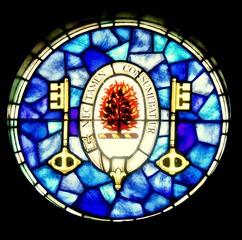On 6th June 1994, Anthony Wilson-Smith wrote the following article in Maclean’s Magazine, and is one of the best accounts of the events of that day in January 1943. The article is transcribed here but can also be read in its original form by clicking on the image below.
Anthony Wilson-Smith in St. Martin-Des-Entrees
Maclean’s Magazine, 6 June 1994
One of the aircraft was too low. That was all too evident to Robert Levoir, even though he was almost two kilometers away, and had been startled by the sudden appearance of five fighter planes dropping from the sky. At 3:29 p.m. on Jan. 15, 1943, Levoir was working peacefully on his farm near the Normandy village of St-Martin-des-Entrees. One minute later, a roar broke the tranquility of the day as the aircraft burst into view, followed by a sharp, spitting noise as they opened fire, with wing-mounted guns, on a slowly chugging German munitions train.
The aircraft were so low that they seemed almost to scrape the tops of the train cars. Then, as swiftly as they appeared, they began to climb out of sight. But, recalls Levoir, now 83, “one of them was lower, and slower to rise.” It struck the top of a 30-m tree and exploded. Parts of the aircraft were later found scattered across a distance of more than 1,800 m.
That crash instantly ended the short life of the Spitfire's pilot, Royal Canadian Air Force Sgt. William Kennedy Ferguson of Peterborough, Ontario, at 22 years of age. But the crash – and the villagers’ subsequent defiance of the Nazis – began a love affair between residents of the village and members of the Ferguson family that is now being formally recognized half a century later.
On June 4, while much of the rest of Europe and North America prepares to commemorate the 50th anniversary of D-Day, the 500 residents of St-Martin-des-Entrees, about 10 km from the Normandy seacoast, will recall the poignant memories of a different-and earlier-wartime encounter with death. At 5:30 p.m., Mayor Christian Dansard will formally unveil two brass plaques that will be placed at either end of the town's short and usually sleepy main street. Most of the residents, as well as Ferguson's younger sister, Mary Pincombe, brother Don, sister-in-law Molly Ferguson and about 15 other Ferguson in-laws and friends travelling from Ontario, will be present. At that moment, the main street of the town, part of a parish that can trace its roots back more than five centuries, will be named Rue de Ferguson, in memory of the young man the residents never knew, but who is invariably described by Dansard and others as “one of our great heroes.”
To understand the depth of feeling in this small French community, It is necessary, says Francois Leostic, “to comprehend how we felt at the time of the crash.” Leostic, a 61-year-old farmer, was the nine year-old son of the town mayor when the crash occurred. Until that point, the Germans had seemed invincible – conquering France with ease three years earlier – while the Allied forces appeared simply invisible. The Germans moved into the area's most comfortable houses, helped themselves to farm supplies and stocks of the powerful locally-made Calvados, and often treated the residents with a mixture of contempt and casual brutality.
The Spitfire raid marked the first time they had seen the Germans under attack, and it gave them hope that the war was not going as badly as German propaganda continually suggested. And in a rural area, where even a trip to the nearby city of Caen was considered a major venture, they could scarcely believe that a young man from a continent across the ocean would, as Leostic says, “care so much about France and the cause of liberty that he would give his life for us.”
The Germans harboured equally forceful, but less charitable, sentiments towards the dead flyer. For 48 hours, the body of Ferguson – who had been dismembered and stripped of almost all his uniform by the force of the crash – was left in an open field under guard. When residents approached, the guards kicked the body and shouted curses. Several small mementos found by local residents, including personal papers and a photograph of Ferguson, were confiscated and destroyed. “They were determined,” says Levoir, “that there should not be any demonstrations of respect, or compassion, towards this man.”
In fact, Ferguson, from his base in the south of England, was a regular visitor to the skies over France. His logbook for the two weeks before he died shows that he flew 12 missions in that time; eight were over France, usually for the purpose of accompanying bombers. He was a willing combatant – his second-last entry, two days before he died, reads “chased two FW-190s, couldn't get a shot at them.” On the day he died, he was returning from a bomber escort mission when he and his mates made the attack that cost him his life. But neither the Germans nor French could have known any of that: there was nothing left to identify the dead man by name.
The Germans decided to hold a quick, unannounced burial on January 18, three days after the crash. But the villagers learned of the Germans' private burial plans, and began making their own. From the moment he first heard of the crash, Francois Godfrey, the town's master carpenter, began working around the clock with his two assistants, making a finely carved, extra-long coffin that would accommodate the remains of the six-foot, one-inch Ferguson. Leon Picant, the firebrand leader of the area's Resistance, began spreading the message that the funeral would take place at the community's historic St-Germain cemetery. And others rummaged through their possessions to find appropriate tributes, such as the precious blue -coloured rosary that Mme. Alphonse Michel had collected years earlier at Lourdes. That, she decided, would be placed inside the coffin with Ferguson to help speed his spirit on its way to its new home.
On the day before the burial, the Germans ordered Godfrey and his helpers to collect the body from the field. Along, with them, close to 150 people came to pay silent tribute as Ferguson’s body was taken by horse-drawn wagon to the cemetery five kilometers away. There, while a handful of German soldiers stood to one side, many of the locals placed on the coffin bouquets of flowers decorated with rosettes, carnations and mimosas in the red, white and blue colours of the French flag. That night, the local priest recited rosaries over the open grave in front of about 15 townspeople.
There were many more mourners the next day. By 10 am, the time the Germans were planning to begin the funeral, the tiny walled cemetery holding the dead of centuries past was filled to overflowing with a mixture of about 250 local residents and visitors from such nearby communities as Vaux-sur-Seulles, Nonant and St-Vigor-le-Grand. The coffin, placed in its two-meter-deep hole, was almost invisible beneath a mountain of ribbons, flowers, wreaths and an artificial palm. Two women held a vase of holy water and nervously debated whether it would be appropriate to anoint the grave of a young man of unknown religion.
After the townspeople had gathered, a small contingent of German soldiers arrived bearing rifles and shocked expressions that reflected their anger and consternation at the size of the crowd. A German officer climbed a nearby burial mound and announced, in heavily accented French: “All those who have placed flowers here and emblems are requested to move them.” Levoir, standing in the middle of the crowd, recalls that “you could almost feel everyone holding their breath, but no one moved.” The standoff lasted about two minutes – a period of time in which the unarmed mix of mostly women, children and elderly men stood nervously, but unbudging, before the increasingly angry soldiers. The silence was broken when the officer ordered the onlookers to take out their identity cards and line up single file for inspection, if they wished to leave the cemetery. At that point, some of the men, including Levoir, took advantage of the milling crowd and confusion to jump the two-meter-high stone wall and flee to safety.
The remainder of the defiant crowd took two hours to proceed past the Germans and out of the cemetery. All had to relinquish their identity cards, which the Germans usually required them to carry at all times or face a prison-camp sentence. By then, German soldiers had removed all the ribbons, wreaths and rosettes emblazoned in the colours of France. It was the French emblems, said a German officer later to Leostic's father, that so enraged them: they were “a bitter insult to the German army.”
At noon, as the last of the townspeople left, the Germans finished burying the coffin. A report of the incident written in 1946 by a local priest, Abbe Desmares, says that by that time, the sun was shining and “the Angelus bell [rang] from our parish steeples in solemn mourning, its sounds floating toward the re-echoing waves of the sea from whence our salvation would surely come.” The defiance of the Germans at the cemetery, Desmares would write, was “a first light in the darkness of German occupation.”
The Germans responded the next day, just as the townspeople knew they would. They interrogated each of the 13 people who had been forced to surrender their identity cards, and then released them. Desmares wrote that one young woman, walking away with her identity card, said: “We are going to pay heavily for this.”
“Then,” replied one parishioner, “let us have no regrets.”
But the Germans did not take their revenge until February 14, Valentine's Day. At about 7:30 p.m. that day, armoured personnel carriers swept into the area and arrested dozens of people. All had been at the funeral. Some were released after being held overnight and beaten. Ten were sent to concentration camps. Five people in all, including Picant and the man who had talked of the importance of having “no regrets,” died in the camps. Their fate only became known after the war.
Nevertheless, the people of St-Martin-des-Entrees have never regretted their decision to defy the Nazis and publicly honor the anonymous flyer. During the war, they paid regular visits to tend his grave and plant flowers. Afterward, they brought out of hiding mementos they had found after the crash, including another photograph of Ferguson and scraps of uniform cloth and notebooks. Those came to be regarded, wrote Desmares, as “glorious relics” to help remember the flyer who had given them hope.
At home in Canada, authorities had told Ferguson's family that he was believed dead, but still officially regarded as missing in action. Little other information was received until early 1945, when the editor of The London Free Press – the newspaper serving the Strathroy area to which the Ferguson family had moved from Peterborough – wrote to a counterpart in Normandy to ask for more information. The letter he received in return, accompanied by a note from a Mme. Marcel Morin – a widow who had witnessed the crash – allowed the military to confirm Ferguson's death.
And there was something else. Ferguson's grave, wrote Morin, “has flowers growing on it, and his family can be assured that it will always be cared for.” Her own husband had been killed elsewhere in France in 1940 and, she wrote, “my four children carry flowers to Sgt. Ferguson's grave, and for them it is a sort of pilgrimage.”
Initially, the Fergusons had planned to bring their son’s body home for burial. After they received that letter, they decided to leave his remains at rest in the cool, shaded cemetery of the town that remembered him so well. His mother, Mary, visited the grave only once; his father, William, whether because of failing health or a broken heart, never did.
Mary Pincombe, the little sister who was 19 years of age when her brother died, acknowledges her memories of her brother Bill have become dimmer over half a century. He was one of six children, a tall, serious' and exceptionally handsome youth whose joys in life included – in no particular order – baseball, basketball and dating girls. He worked as an insurance agent briefly after graduating from high school before enlisting in early 1940, at age 19.
Pincombe and her husband, Dick, visited the town in 1989. They speak no French; none of the townspeople speak more than a few halting words of English. Despite that, once it became understood that she was Ferguson’s sister, “we were led to understand that we had now acquired a whole new family in the people of St-Martin-des-Entrees,” she says. They met Morin, shortly before her death in 1990, along with several of her children. And they spent many hours in the 17th-century farmhouse now owned by Leostic, drinking anisette and Calvados and exchanging memories in pidgin English, French and sign language.
Last May, the Pincombes received a letter from Mayor Dansard, carefully translated into English. It asked for permission to name the town's main street after William Ferguson “in order to keep in our memories a souvenir of his ultimate sacrifice.”
The people of St-Martin-des-Entrees, says Dansard, who was not even born until five years after the war, “have an automatically warm feeling every time they hear the word ‘Canada’.” That is reflected in the poem at the start of Desmares’s memoirs. In translation, it reads:
To Canada, mysterious and distant,
To her airmen,
To all her sons fallen among us for our deliverance,
We send our love and gratitude.
Perhaps that is why Mary Pincombe, when she sits in her Strathroy home and thinks of visiting France and seeing Francois Leostic, his family and her other friends at her brother’s grave next week, says: “It’s not so much a case of going away as it is of coming home.” Between the surviving Fergusons and the people of St-Martin-des-Entrees, there is a bond built on the memory of a long-dead young man, sealed ultimately in blood and sorrow. It will not easily be broken.
~ oooOooo ~







